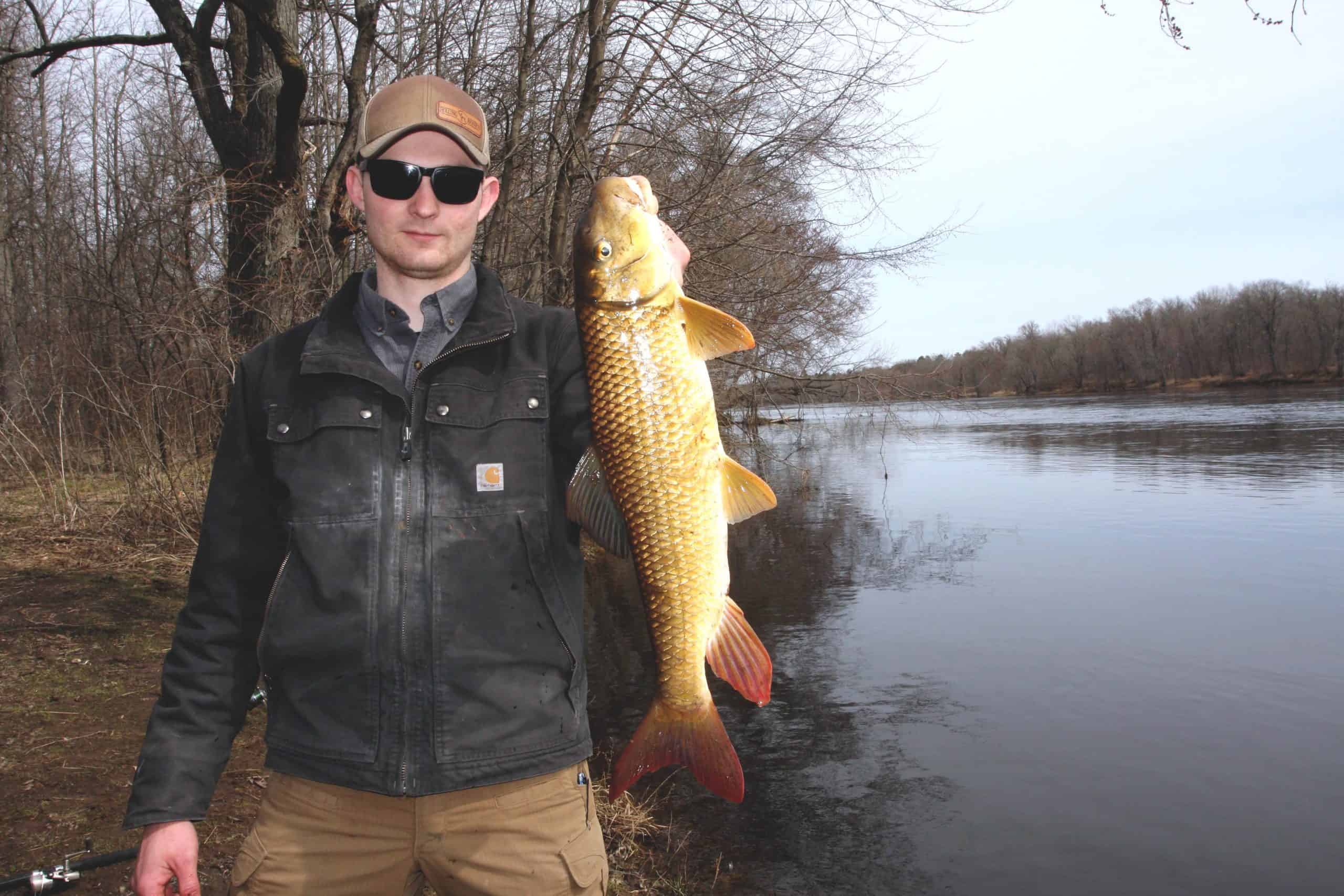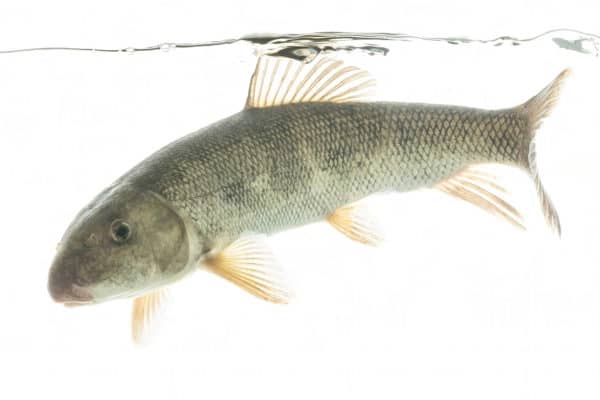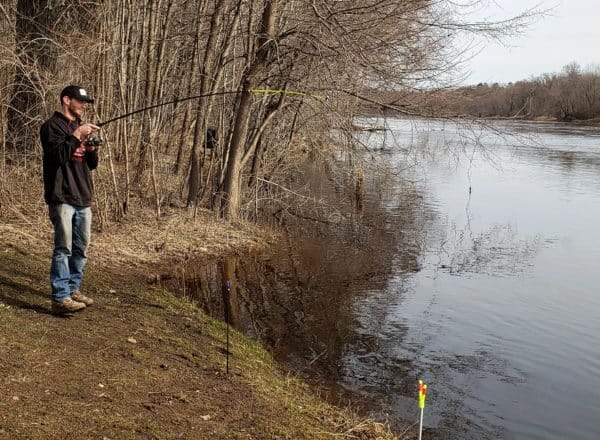
USA member Jake Johnson of the Law Enforcement Labor Services union shows off a broad-shouldered redhorse sucker taken from the St. Croix River along the Minnesota and Wisconsin border.
By Dan Johnson
Spring brings an abundance of fishing options virtually coast to coast. Bass, panfish and walleyes are popular targets, but overlooked species are also on the table. Suckers, for example, swim under the radar of the masses, yet offer fast action and a hard fight for those who practice the following spring sucker fishing tips. As a welcome bonus for anyone interested in catching fish to eat, they’re also extremely tasty table fare.
“Suckers don’t get any limelight and are sometimes even looked down upon, but these clean, native fish put up a doggone good fight and taste great,” says legendary fishing guide, Plano Synergy pro and staunch Union Sportsmen’s Alliance (USA) supporter Brian “Bro” Brosdahl.
Although Brosdahl is best known for catching trophy bluegills and walleyes, he has long been a fan of chasing suckers, particularly during the spring spawning run. “Suckers run upstream to spawning areas, gathering in classic areas of reduced current along the way,” he says. “Find a holding area and fast fishing is the rule.”
A Bit About Suckers
The sucker family (Catostomidae) includes more than 70 freshwater species found in a variety of habitats across North America. Besides offering anglers fishing opportunities, many of these species—such as the white sucker—are critical components of the food chain, providing important forage for predators such as walleyes, northern pike and largemouth bass.

The white sucker is an important forage species in many North American fisheries.
Unfortunately, suckers are under siege in some fisheries. A variety of threats including habitat degradation, environmental contamination, migration barriers and impacts from non-native species threaten sucker populations in different regions. Public misconceptions that suckers tolerate poor water quality and are of no value to anglers or the ecosystem don’t help matters, either.
Researchers with the U.S. Geological Survey contend that habitat protection and education/outreach programs, such as those in the USA’s Work Boots on the Ground Program, can play a vital role in protecting and restoring threatened populations of these and other important native species.
“We’re always looking for fish and wildlife conservation projects and outreach opportunities large and small,” said USA Conservation Manager Rob Stroede. “If you have an idea for an event or project, or would like to volunteer in one, please let us know at conservation@unionsportsmen.org. There are still opportunities to get involved during the COVID-19 crisis through our Persevere and Volunteer campaign. CLICK HERE for details.”
Thankfully, many healthy lake and river systems are still flush with suckers. Brosdahl notes that shore fishing for them is a perfect fit for responsible outdoor use during the COVID-19 pandemic. “Fishing solo, or having a couple of fishing buddies spread rods six feet or more apart along a remote riverbank, are ideal for practicing social distancing,” he reports. “It’s a great alternative when crowded banks, piers and boat ramps are out of play.”
Bro’s Tips and Tricks
Brosdahl’s sucker strategies are straightforward. “One of my favorite locations is where a relatively clean-flowing tributary stream enters the main river above a necked-down area like a bridge,” he says. “The combination of reduced current and a clean inflow collects spring suckers by the school.” Other strike zones include the downstream side of a sandbar below a feeder stream, and slack water created by points and other obstructions. Sometimes the intersection of slick and slack water is key, but it pays to experiment.
Since some of the best spots are reached on foot, often via hiking trails or blazing your own trail through the backcountry, make sure your apparel is up to the task. Durable outerwear is a must. USA partner Carhartt offers a variety of boots and clothing perfect for serious fishing adventures. For example, the company’s lightweight yet heavy-duty Shoreline Jacket is also waterproof and breathable, for solid comfort no matter the conditions.
Suckers require no special fishing tackle. A 6- to 6½-foot, medium or medium-light spinning outfit spooled with 6 or 8-pount monofilament line is perfect for many situations. Brosdahl favors 12-pound suberbraid mainline, tipped with a short fluorocarbon leader of slightly lighter test than the braid. For efficiency, mobility and ease of packing into remote fishing areas, he stocks a Plano Edge tacklebox with an assortment of small baitkeeper, circle and Aberdeen hooks. Bass Pro Shops’ Bronze Baitholder Hooks are a great example. “Size 4 hooks are often the best choice, but bring a few different sizes so you can match the bait, conditions and mood of the fish,” he notes.
“Same with sinkers,” he continues. “Pack a variety of small split-shot and slip sinkers, with a few pyramid and flat sinkers up to 2 ounces for holding bottom in strong current. Keeping the rig in place, rather than having it roll around or bounce downstream, is key to allowing suckers to home in on it.”
Brosdahl typically uses nightcrawlers for bait, but says where available (and legal), clam strips can be top producers. “Thread bait on the hook so the barb is covered, or suckers will feel it when taking the bait,” he advises.
Presentation is as simple as it gets. Cast out, let it hit bottom, and either hold the rod or place it in a rod-holder or Y-stick while waiting for a bite. “Suckers take the bait in a ‘tap-tap-tap’ manner, so you’ll feel the bite or see the rodtip dance,” Brosdahl explains. “When it happens, resist the urge to make an eye-crossing hookset. Reel down until you feel the weight of the fish, and make a firm but controlled sweep-set. With a circle hook, reeling is enough to set the hook.”
Landing suckers can be as basic as sliding them up on the bank. When practicing catch-and-release, however, Brosdahl recommends a fish-friendly landing net like those in Frabill’s Conservation Series.

USA member Josh Johnson of SMART Local 209 battles a spring-run redhorse.
Fine Dining
Sometimes erroneously considered “trash” fish, suckers taken from clean, clear, cold water are excellent on the table. Doug Stange, editor in chief of USA ally In-Fisherman Publications, reports that suckers are commonly smoked or pickled, but also excel when filleted and deep fried or ground into patties.
“Suckers make the sweetest, most wonderful fish patties I’ve ever tasted, patties alone worth the price of a relaxing afternoon on a sunny riverbank,” Stange says. CLICK HERE for more of Stange’s spring sucker fishing tips.
To be sure, suckers are undeniably bony. “Score through small bones that run through the fillets, so portions can be easily eaten when deep-fried,” Stange advises. “Smoked sucker is a delicacy, and a favorite spring snack in many rural towns,” Brosdahl adds. “The meat peels easily off the bones and is delicious.”
However you slice them—and even if you don’t—suckers are spirited fighters perfect for targeting along riverbanks and lakeshores this spring. The action extends into summer and beyond, too, but that’s a story for another day.



